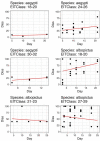Identifying Knowledge Gaps through the Systematic Review of Temperature-Driven Variability in the Competence of Aedes aegypti and Ae. albopictus for Chikungunya Virus
- PMID: 38003832
- PMCID: PMC10675276
- DOI: 10.3390/pathogens12111368
Identifying Knowledge Gaps through the Systematic Review of Temperature-Driven Variability in the Competence of Aedes aegypti and Ae. albopictus for Chikungunya Virus
Abstract
Temperature is a well-known effector of several transmission factors of mosquito-borne viruses, including within mosquito dynamics. These dynamics are often characterized by vector competence and the extrinsic incubation period (EIP). Vector competence is the intrinsic ability of a mosquito population to become infected with and transmit a virus, while EIP is the time it takes for the virus to reach the salivary glands and be expectorated following an infectious bloodmeal. Temperatures outside the optimal range act on life traits, decreasing transmission potential, while increasing temperature within the optimal range correlates to increasing vector competence and a decreased EIP. These relatively well-studied effects of other Aedes borne viruses (dengue and Zika) are used to make predictions about transmission efficiency, including the challenges presented by urban heat islands and climate change. However, the knowledge of temperature and chikungunya (CHIKV) dynamics within its two primary vectors-Ae. aegypti and Ae. albopictus-remains less characterized, even though CHIKV remains a virus of public-health importance. Here, we review the literature and summarize the state of the literature on CHIKV and temperature dependence of vector competence and EIP and use these data to demonstrate how the remaining knowledge gap might confound the ability to adequately predict and, thus, prepare for future outbreaks.
Keywords: Aedes aegypti; Aedes albopictus; EIP; EIT; chikungunya; extrinsic incubation period; extrinsic incubation temperature; temperature; transmission.
Conflict of interest statement
The authors declare no conflict of interest.
Figures







Similar articles
-
Vector competence of Aedes aegypti in transmitting Chikungunya virus: effects and implications of extrinsic incubation temperature on dissemination and infection rates.Virol J. 2016 Jun 29;13:114. doi: 10.1186/s12985-016-0566-7. Virol J. 2016. PMID: 27357190 Free PMC article.
-
Vertical transmission of Indian Ocean Lineage of chikungunya virus in Aedes aegypti and Aedes albopictus mosquitoes.Parasit Vectors. 2016 Apr 23;9:227. doi: 10.1186/s13071-016-1505-6. Parasit Vectors. 2016. PMID: 27108077 Free PMC article.
-
Temperature Increase Enhances Aedes albopictus Competence to Transmit Dengue Virus.Front Microbiol. 2017 Dec 1;8:2337. doi: 10.3389/fmicb.2017.02337. eCollection 2017. Front Microbiol. 2017. PMID: 29250045 Free PMC article.
-
Temperature and transmission of chikungunya, dengue, and Zika viruses: A systematic review of experimental studies on Aedes aegypti and Aedes albopictus.Curr Res Parasitol Vector Borne Dis. 2023 Aug 24;4:100139. doi: 10.1016/j.crpvbd.2023.100139. eCollection 2023. Curr Res Parasitol Vector Borne Dis. 2023. PMID: 37719233 Free PMC article. Review.
-
Invasiveness of Aedes aegypti and Aedes albopictus and Vectorial Capacity for Chikungunya Virus.J Infect Dis. 2016 Dec 15;214(suppl 5):S453-S458. doi: 10.1093/infdis/jiw285. J Infect Dis. 2016. PMID: 27920173 Free PMC article. Review.
Cited by
-
On the tracks of an uninvited guest, the Asian tiger mosquito, Aedes albopictus in Cyprus.Parasit Vectors. 2025 Feb 4;18(1):39. doi: 10.1186/s13071-024-06651-5. Parasit Vectors. 2025. PMID: 39905537 Free PMC article.
-
Current and Future Spatial Distribution of the Aedes aegypti in Peru Based on Topoclimatic Analysis and Climate Change Scenarios.Insects. 2025 May 2;16(5):487. doi: 10.3390/insects16050487. Insects. 2025. PMID: 40429200 Free PMC article.
-
High vector competence for chikungunya virus but heavily reduced locomotor activity of Aedes albopictus from Germany at low temperatures.Parasit Vectors. 2024 Dec 4;17(1):502. doi: 10.1186/s13071-024-06594-x. Parasit Vectors. 2024. PMID: 39633401 Free PMC article.
References
-
- World Health Organization Chikungunya. [(accessed on 15 November 2023)]. Available online: https://www.who.int/health-topics/chikungunya#tab=tab_1.
LinkOut - more resources
Full Text Sources
Miscellaneous

